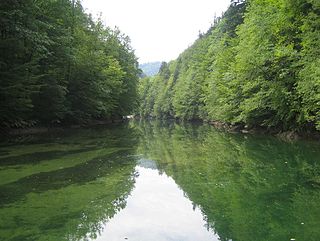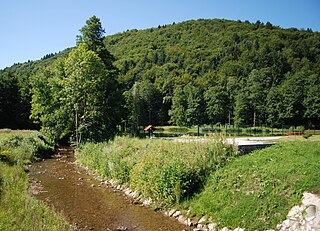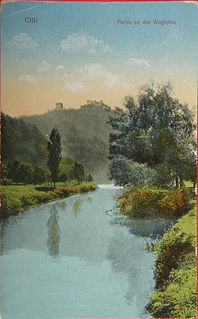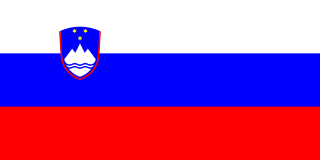
The Mur or Mura is a river in Central Europe rising in the Hohe Tauern national park of the Central Eastern Alps in Austria with its source being 1,898 m (6,227 ft) above sea level. It is a tributary of the Drava and subsequently the Danube.

The Meža (Slovene) or Mieß (German) is a river in the Austrian state of Carinthia and in Slovenia, a right tributary of the Drava. It is 43 km long, of which 42 km in Slovenia. Its catchment area is 551.7 km2, of which 543 km2 in Slovenia.

The Dravinja is the largest tributary of the Drava River in Slovenia. It is 73 kilometres (45 mi) long. Its source is on the Pohorje Massif southwest of Mount Rogla about 1,150 m above sea level. The river passes Zreče, the town of Slovenske Konjice, the ruins of the fort at Zbelovo, Poljčane, Makole, Štatenberg Castle, Majšperk, and Videm pri Ptuju, where it merges with the Drava. Its main tributary is the river Polskava.

The Sutla (Croatian) or Sotla (Slovene) is a river flowing through Slovenia and Croatia, mostly forming their border. It is a tributary to the Sava, itself a tributary to the Danube. It is 89 kilometres (55 mi) long and has a watershed area of 584 square kilometres (225 sq mi).

The Kupa or Kolpa river, a right tributary of the Sava, forms a natural border between north-west Croatia and southeast Slovenia. It is 297 kilometres long, with its border part having a length of 118 km (73 mi) and the rest located in Croatia.
The Ložnica is a river in Slovenia, a left tributary of the Savinja in Celje. It is 26 kilometres (16 mi) long.

The Pesnica is a river in Styria, southeastern Austria and Styria, northeastern Slovenia. It is 69 km long, of which 65 km in Slovenia. Its catchment area is about 550 km2, of which 539 km2 in Slovenia. Its source is near Glanz an der Weinstraße, near the Austrian-Slovenian border. It passes Zgornja Kungota, Pesnica, Pernica, the castle at Hrastovec v Slovenskih Goricah, Lenart v Slovenskih Goricah, the monastery of Sveta Trojica v Slovenskih Goricah, Dornava, and Velika Nedelja, and then merges with the Drava near Ormož, on the border with Croatia.

The Idrijca is a river flowing through the Idrija Hills and Cerkno Hills. It is 60 kilometres (37 mi) long. It rises near Vojsko, flows towards northeast and after passing through Idrija turns to the northwest. After passing through Spodnja Idrija and Cerkno it joins the Soča in Most na Soči. It has the pluvio-nival regime and belongs to the Adriatic Sea Basin.

The Reka, also the Inner Carniola Reka, is a river that starts as Big Creek in Croatia, on the southern side of Mount Snežnik, and flows through western Slovenia, where it is also initially known as Big Creek. The river is 54 kilometres (34 mi) long, of which 51 km in Slovenia. At the village of Škocjan it disappears underground through Škocjan Caves, flowing 38 km (24 mi) underneath the Slovenian Karst. The river continues as part of the Timavo in Italy, however, tracer studies have shown that it also feeds springs elsewhere on the Adriatic Coast between Trieste and Monfalcone. It has the pluvial regime.

The Mirna is a river in southeastern Slovenia. The river, in which the marathon swimmer Martin Strel first learned to swim, is a right tributary of the Sava River in the province of Lower Carniola. It is 44 kilometers (27 mi) long, starts below the settlement of Velika Preska, flows through the Mirna Valley and joins the Sava at Dolenji Boštanj, opposite Sevnica. The largest settlement on the river is Mirna. The river is traversed by the Sevnica–Trebnje Railway. The river was mentioned for the first time in 1028 in relation to a 1016 document by Henry II, Holy Roman Emperor.

The Paka is a 40 km (25 mi) long river in Slovenia. It flows through Velenje and it joins the Savinja as a left tributary.

The Voglajna is a river in Styria, Slovenia. The river is 35 kilometres (22 mi) long, and its catchment area is 412 km2 (159 sq mi). Its source is Lake Slivnica near Slivnica pri Celju. It passes Šentjur, the ruins of Rifnik Castle, and Štore, and then merges with the Savinja River in Celje.

The Kamnik Bistrica is an Alpine river in northern Slovenia, a left tributary of the Sava River. It springs from the Kamnik Alps near the border with Austria. It is 33 km (21 mi) long. The Kamnik Bistrica flows through the town of Kamnik, where it is fed by the Nevljica River. It flows into the Sava south of Videm, about 10 km east of Ljubljana.

The Kokra is a river of Slovenia. Originating in the Karawanks, the river is 34 km (21 mi) long. It flows into the Sava in Kranj.

The Iška is a river of central Slovenia. Part of the river valley—the Iška Gorge or Iška Canyon —separates Lower Carniola from Inner Carniola. The river is 31 km (19 mi) long. After flowing past Strahomer, the river follows an almost straight line and joins the Ljubljanica River, and therefore belongs to the Sava and Black Sea basins.

The Pšata is a river of Slovenia. The river is 28 km (17 mi) long. It is a right tributary of the Kamnik Bistrica, which merges with the Sava east of Ljubljana, the capital of Slovenia.

The Pivka is a karst lost river in Slovenia. The river is 27 kilometres (17 mi) in length. The Pivka ends in Planina Cave, where it merges with the Rak River and then the Unica River. The confluence of the Pivka and the Rak is one of the largest subterranean confluences in Europe. The Pivka created Postojna Cave, the longest cave system in Slovenia as well as one of its top tourism sites.

The Dragonja is a 30-kilometre (19 mi) long river in the northern part of the Istrian peninsula. It is a meandering river with a very branched basin and a small quantity of water. It has the pluvial regime and often dries up in summer. It features very diverse living environments and is home to a number of animal and plant species. The Dragonja has been a matter of a territorial dispute between Croatia and Slovenia, with its lowest portion de facto the border of the two countries.

Ločica pri Vranskem is a settlement in the Municipality of Vransko in central Slovenia. It lies at the crossroads of the regional roads leading to Kamnik, Celje, and Ljubljana in the valley of Bolska Creek, a right tributary of the Savinja River. The Slovenian A1 motorway passes just east of the village core. The area is part of the traditional region of Styria. The municipality is now included in the Savinja Statistical Region. It includes the hamlets of Bistrica, Brce, Jakov Dol, and Osredek.























